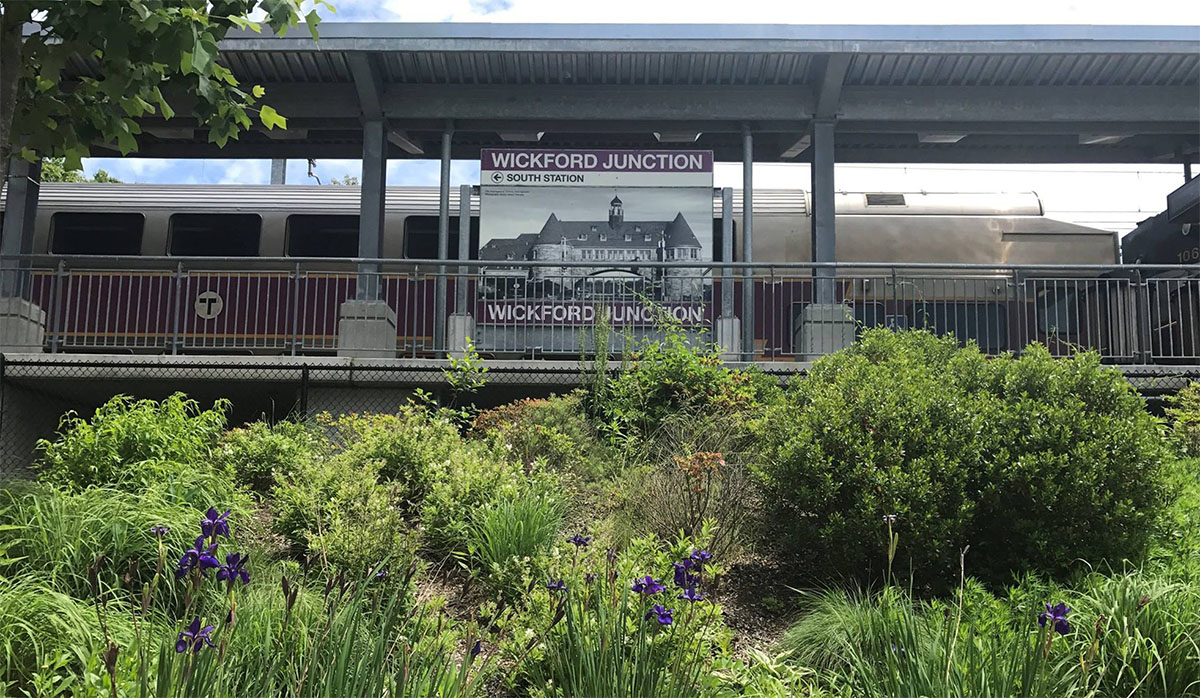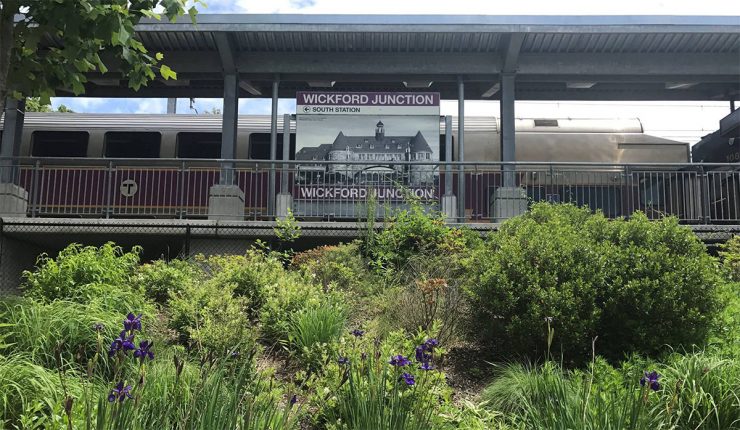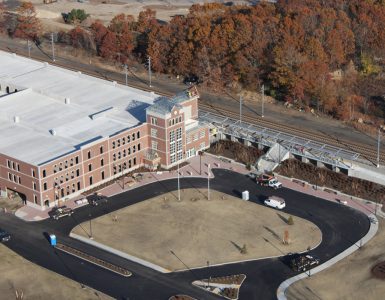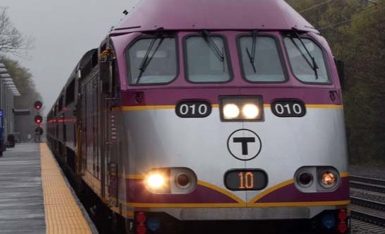
Wickford Junction Station, image from RIDOT.
“We started a few months ago, doing a deep dive looking into what the MBTA can do, what it can’t do and why,” [RIDOT Director Peter] Alviti said. “Peak periods [are] quite a challenge for them to be able to give us more frequency during rush hours.”
The constriction relates to the design of the MBTA hub at South Station in Boston, according to Devine. It becomes a choke point during rush hours. “Without an expansion in additional capacity and trackage there, it really limits increasing the trains [to Rhode Island], particularly in the peak period,” he said.
Taking over the services themselves, however, would allow RIDOT to contract out the operations to a company that only has to cycle between Wickford Junction and Providence, and which might allow for future expansion.
The article goes on to discuss the need to add housing to the stop at Wickford Junction to provide a built-in client base for the service (true TOD, not a Home Depot and a Walmart) and also the potential for service to Quonset, which is an expanding jobs center.
We’re not going to tear down the $40 million station at Wickford Junction, so how do we make it work?






The end of this PBN headline is something I do not agree with. Privatizing is a terrible idea. the reason why it’s failing is because headways/frequency is way too low. there also needs to be much better bus/biking connections to wickford village and much more TOD around wickford station and the tf green station. wickford station is placed in a very inconvenient place cause of the rail alignment of the northeast corridor tracks and the only other option MBTA had would be to create a spur that goes closer to wickford village but the logistics of that probably would be a nightmare. Better bus connection to wickford village is key cause as of now there isn’t any direct bus from the station to wickford village. It takes over an hour to get from wickford village, which is only 2.6 miles from the station, but having to transfer to the 14, it’s a very indirect route. an hour by bus to travel to a village that’s only 2.6 miles from the station is unacceptable. there needs to be some sort of shuttle service to wickford village from wickford station.
What Mark wrote makes sense.
I don’t understand why they don’t have rail service at night as well. A good friend of mine lives in Peace Dale, and has said many times that she wishes she could take the train to Providence on nights when we go to the theatre or out to dinner. Especially on Waterfire nights, where there’s no parking at all and traffic is insane, why not give people that option? The success of the Newport ferry shows that people do like public transit, if it’s going where they want to go when they want to go.
Direct RIPTA service from Newport and URI timed with the trains would go a long way.
Add a few more frequencies, even if just in-state and have 50-75% of the existing south county and Newport RIPTA service start/end at Wickford
Every RI train station should have residential development co-located onsite. A ~10 station stop intra-state rail system (Woonsocket, Ashton(Cumberland)/Lincoln or elsewhere in Cumberland, Pawtucket/CF, Providence, Olneyville, Cranston, TF Green, EG?, Quonset?, Wickford, Kingston, Westerly) could have an embedded ridership of 2,000 people fairly easily if there were apartments located next to train stations and frequency was increased. There are countless examples of how this would work well. Service could even be extended to Stonington, Mystic, and New London (connection to Fisher’s Island and the Cross Sound Ferry). Pipe dream: the extra slack alleviated by transferring some service to intra-RI trains could allow for the MBTA to extend regular service to Newport.
This approach of investing a fraction of what is needed and then criticizing the entire incomplete system when it doesn’t function as a well designed mass transit system is ridiculous. Rhode Islanders should not be driving into Providence for work, school, f&b, or entertainment — they should be parking at de-centralized parking structures at train stations and taking public transit into the city. If the system needs baseline “early adopters”, there is no better way than having people living right at a train station.
It already is privatized. Does PBN just mean RIDOT should be able to choose its own contractor instead of relying on MBTA’s contractor, or did they miss that minor detail in their quest for a good anti-government sound bite?
RIPTA is in the process of buying new fare-boxes. Will it be compatible with MBTA fare products? Both at TF Green and Wickford Jct the rail service is supplemented by a lot of RIPTA service, but it is a hindrance to bus/rail/round trips that they now have separate fare products.
What is the potential of the old rail line from Wickford Jct to Wickford (that is why the stop was called a “junction”) for a bike connection between the two?
By the way, the Providence City Council passed an anti-bike resolution 9 to 6, worth a separate story.
…Wickford Junction, so how do we make it work?
Fuhgeddaboudit. Thinking we somehow must fix this gets in the way of identifying and fixing stuff that would make bigger differences sooner cheaper and for more people.
The solvable problem is how to make car-free or car-lite living less impossible in areas where the population is already dense enough to ensure success.
There are two problems facing commuter rail past Providence: high fixed operating costs and low ridership. There is no question that greater frequency, including evening and weekends would increase ridership, as would additional stops at Kingston and Quonset. Better bus service to station stops is critical, and bike trails are needed for connections to Wickford and URI.
Privatization is not the issue for controlling costs, MBTA control is. Operating costs are out of control because the service is tagged on to the end of the Stoughton line, even though most riders are commuting to Providence. Labor is the biggest cost component of commuter rail, and MBTA trains require an engineer and several conductors to collect fares. Smaller, self propelled rail cars running between Providence and Kingston, sized for RI ridership, would be much faster and cheaper to operate, and a single fare, collected at turnstiles like a subway line, would dramatically reduce labor costs. It would also be a perfect opportunity to have a single fare system for both rail and bus.
The area around Warwick and Providence stations are the best places for TOD. Wickford Junction would probably require more commercial development at Warwick and Providence to attract residential development near the train station, but if someone like Amazon would land downtown, it would happen in a heartbeat.
I don’t think there is natural daily demand for commuter rail past Kingston. It would take a lot more rolling stock, and station stops on the NEC are expensive (think Pawtucket’s $40 MM price tag), so I would stop there. Woonsocket/Cumberland would work if P&W would make the necessary track upgrades. It is much easier to operate off the NEC, Woonsocket has a terrific station, ideal for TOD, and it could be a regional RIPTA bus hub for the NE corner of the State.
Smaller self propelled cars in RI would help.
Tom, I assume you mean self driving cars (all cars are self-propelled). Yes, autonomous vehicles will have a major impact on transit, especially for the first and last mile traveled. However, it will probably make in-between transit, like commuter rail, even more popular.
Interestingly, the technology is already in use for autonomous rail systems, so why not on a commuter rail line from Kingston to Providence? The challenge is whether the technology can detect obstacles on the track far enough ahead (or at least as far as a person can) to stop in time, since trains can’t stop as quickly as cars.
Sorry
I meant the single
self propelled rail passenger cars. an updated version of the diesel powered Budd cars of 60 years ago
As others mentioned, the main problems are the limited schedule and inaccessibility of getting to your final location when taking the train to Wickford Junction.
I live in Providence and work in South Kingstown, but the its hard to make all the schedules align between the train times & bus times, and have a reasonable door-to-door commute time. What takes me 35 minutes without traffic in my car could be 1.5 hours (walking to the station, riding the train, waiting for a bus, ridin87ioujknm g the bus, walking to final destination).
I think one easy change that would help some would be to allow bikes on the trains during commuting times. These trains aren’t full and can certainly accommodate a few bicycles during commuting hours on the line between Wickford Junction and Providence.
Tom, sorry, I misunderstood. I completely agree, self propelled rail could be right-sized for traffic between Kingston and Providence. They would be cheaper to operate, and could run at faster speeds, than MBTA trains pulled by diesel locomotives. Also completely agree with Chris. It is increasingly common that such cars are equipped with interior bike racks.
Privatization is not the answer. Location and overall design are just as important as headway and frequency.
i.e. The airport station is a mammoth of construction with hardly any visual or pedestrian appeal, while the Wickford station is simply in the wrong location.
We ought to look at why and where, we historically had stations and rail service prior to their removal. These stations were located in population rich areas with connections to a number of other ports and modes of transport and commerce.
Andy’s last point “We ought to look at why and where, we historically had stations and rail service prior to their removal.”. That’s the major point right there.
Bottom line, is we were extremely short sighted removing rail stations and service. Furthermore, we are doubling down on that shortsightedness by tearing up rail ROWs and installing bike paths (in New England in general). Keep the original ROWs and put in lots of (cheaper) flag stops — we don’t need $40,000,000 dollar infrequently used trophy stations.
I agree that transit can be a powerful driver of development if it is in the right place. The airport commuter rail station isn’t much to look at, but there is lots of potential for TOD, particularly if the rail and airport connections were more integrated with local transit. As Wickford demonstrates, it’s about much more than parking.
A great example of location and overall design is the Woonsocket station, an architectural gem located right in town, but I would say that speed and reliability are equally important. If commuter rail between Woonsocket and Providence ever takes hold, an additional station stop should be added near the most densely populated areas of Lincoln, North Providence and Central Falls, in an area conducive to TOD.
I think most of the ROWs that have been repurposed for recreational use were old freight lines serving manufacturing facilities that are long gone, which makes it hard to justify keeping them in light of the high cost of maintaining the rail beds. The reason that new station stops, like in Pawtucket, cost $40,000,000 is because stops on the NEC require rail sidings for acceleration and deceleration (traffic on the ROW has to be at “cruising speed”); very little of the cost is for the actual station.
Well said